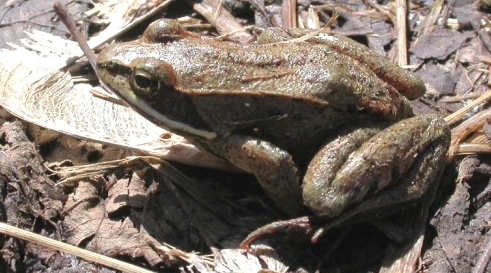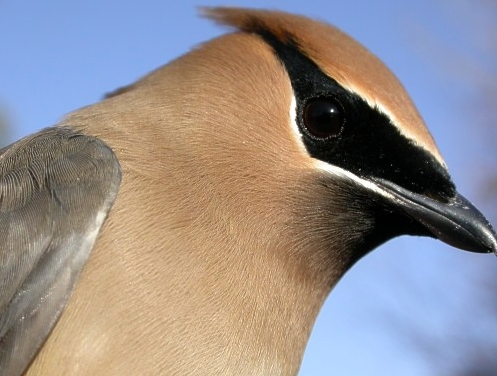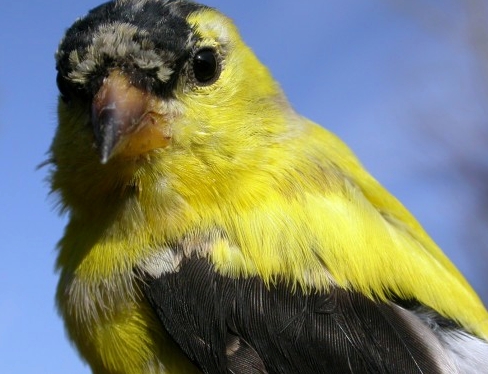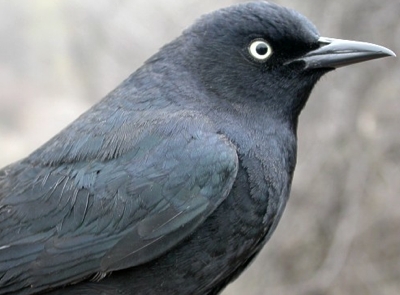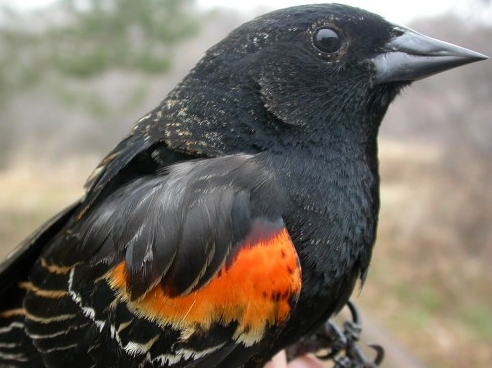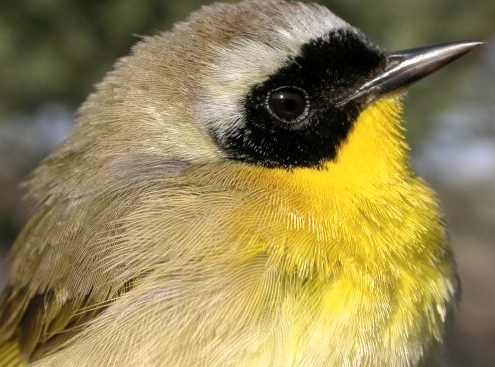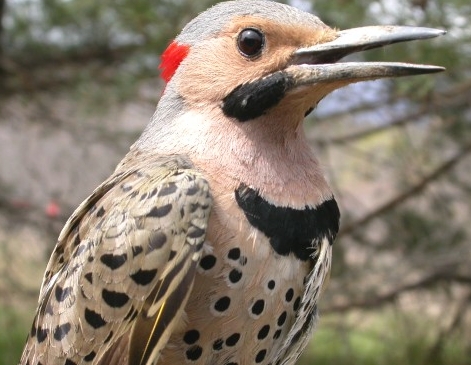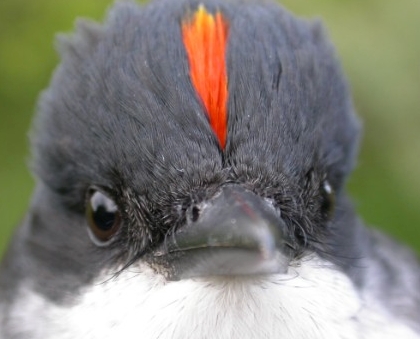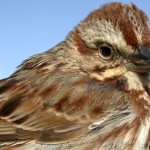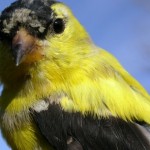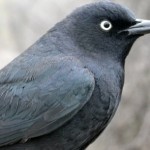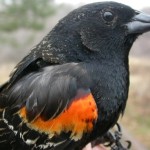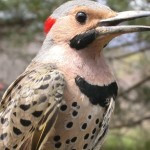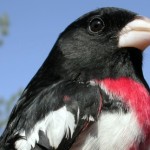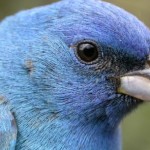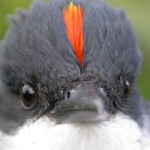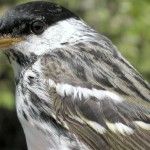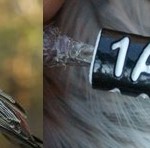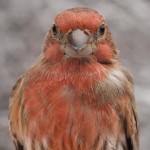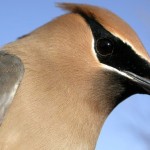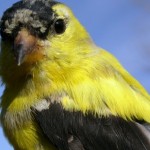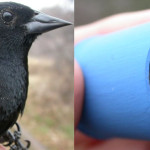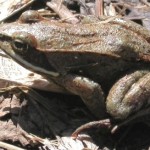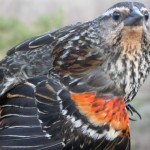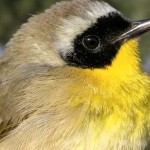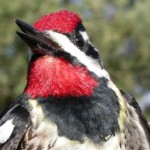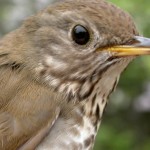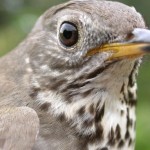Spring migration monitoring ten-week programme
* Download a full season summary and analysis here
Week 1: Mar 28 – Apr 3, 2005
| THIS WEEK | WINTER TOTAL | YEAR TOTAL | SITE TOTAL | |
|---|---|---|---|---|
| # birds (and species) banded | — | 256 (14) | 59 (10) | 980 (49) |
| # birds (and species) repeat | — | 109 (9) | 34 (2) | 212 (17) |
| # birds (and species) return | — | 10 (3) | 10 (3) | 12 (4) |
| # species observed | — | 36 | 26 | 138 |
| # net hours | — | 110 | 58 | 1032.5 |
| # birds banded / net hour | — | 231.8 | 101.7 | 94.8 |
Week 2: April 4-10, 2005
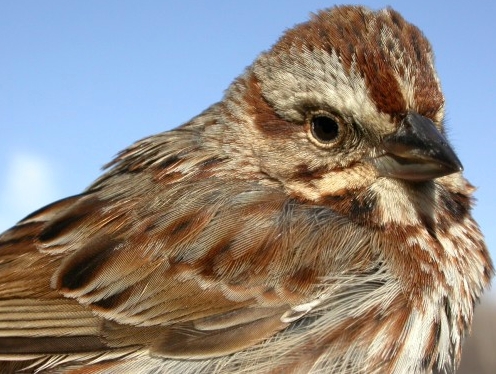
A milestone at MBO – the Song Sparrow above was our 1000th bird banded since starting operations last May. An appropriate species with which to mark the occasion,as later the same day we banded our 100th Song Sparrow!
| THIS WEEK | WINTER TOTAL | YEAR TOTAL | SITE TOTAL | |
|---|---|---|---|---|
| # birds (and species) banded | 19 (7) | 19 (7) | 78 (15) | 999 (49) |
| # birds (and species) repeat | — | — | 34 (2) | 212 (17) |
| # birds (and species) return | 2 (1) | 2 (1) | 12 (3) | 14 (4) |
| # species observed | 51 | 51 | 55 | 142 |
| # net hours | 115.3 | 115.3 | 173.3 | 1147.8 |
| # birds banded / net hour | 16.5 | 16.5 | 45 | 86.9 |
Bander-in-charge: Marcel Gahbauer
Banding assistants: Shawn Craik, Jean Demers, Gay Gruner, Marie-Anne Hudson, Barbara Macduff, Betsy McFarlane, Crissy Ranellucci, Clemence Soulard, Kim Tendland-Frenette
Notes: Thanks to a dedicated volunteer crew, we got all of the main spring nets up on Tuesday morning. Taking advantage of some tricks we first applied to the winter nets, all are now top-tied, making it much easier to walk past the nets. Most nets are in the same places as last fall, but an extra net has been added to the “B” section along the ridge north of the banding station, and an “A” net has been inserted between “C” and “D”, on the ‘inside’ of the main loop path. The small weekend crews also did a great job at cleaning up much of the junk that had accumulated on the site for two decades prior to the establishment of MBO.
Tuesday was windy, and so we only caught two birds – an Eastern Phoebe and an American Tree Sparrow. Saturday morning, our first bird was a Song Sparrow in D3, and it was our 1000th bird banded at MBO since we began operations in May 2004 (owls included). Sunday we followed up with our first two returns of the spring, both of them Song Sparrows banded here last October. A small flock of five American Goldfinches hit the net together, showing a remarkable range of moult among them.
New species have been arriving daily this week, including Eastern Phoebe (Tuesday), Golden-crowned Kinglet (Wednesday), Fox Sparrow (Thursday), Killdeer (Friday), Tree Swallow (Saturday), Chipping Sparrow and Belted Kingfisher (Sunday) . Also, there have been a remarkable four additions to the overall site checklist this week. Three were just flying by overhead – Double-crested Cormorant, Great Black-backed Gull, and Iceland Gull. However, on Sunday three Hooded Mergansers were seen swimming in the back pond, and we hope they might stay for a while along with the many Wood Ducks (as many as 13).
Last but not least, the migrant birds aren’t the only ones making their first appearances of the year. On Saturday the first Spring Peepers began calling from the back ponds late in the morning, and the Wood Frog below was spotted on the back access road. A few flies and moths were seen too, but it will (hopefully) be a while yet before the mosquitoes begin harassing us while we check the nets near the water.
Week 3: April 11-17, 2005
| THIS WEEK | WINTER TOTAL | YEAR TOTAL | SITE TOTAL | |
|---|---|---|---|---|
| # birds (and species) banded | 17 (8) | 36 (10) | 95 (17) | 1016 (49) |
| # birds (and species) repeat | 5 (2) | 5 (2) | 39 (2) | 217 (17) |
| # birds (and species) return | — | 2 (1) | 12 (3) | 14 (4) |
| # species observed | 41 | 54 | 58 | 143 |
| # net hours | 61.2 | 176.5 | 234.5 | 1209 |
| # birds banded / net hour | 27.8 | 20.4 | 41.8 | 84 |
Bander-in-charge: Marcel Gahbauer
Assistants: Jean Demers, Christina Donehower, Gay Gruner, Marie-Anne Hudson, Barbara MacDuff, Michael Mayer, Crissy Ranellucci, Clemence Soulard
Notes: The weather has been glorious over the past week, consistently sunny and pleasant. However, this stable high pressure system has also been accompanied by steady light north winds, and that has resulted in migration largely stalling. Early in the week new migrants included Yellow-bellied Sapsucker and Brown Thrasher, and on Saturday our first ever Pied-billed Grebe was observed, but other than that no new arrivals were noted.
Banding this week took place only on Tuesday due to logistical constraints. We were fortunate to catch part of the flock of waxwings that has been hanging around over the past week, though the Bohemians evaded us. The rate of capture remains relatively low, but improved over last week, and will likely continue to rise as the diversity of migrants increases and more birds settle into the lower vegetation rather than just flying by overhead.
Week 4: April 18-24, 2005
![[Left] One of the most common breeding birds at MBO, Red-winged Blackbirds have nonetheless avoided the nets so far this spring. The first one caught was this second-year male, still showing much rusty edging on the wings and back, and with orange rather than fully red epaulets. [Right] A male Ruby-crowned Kinglet hanging out in one of our newest weighing tubes. These, inspired by similar ones in use at Prince Edward Point Bird Observatory in Ontario, allow us to put the bird in for weighing from one end, and then remove a cap from the other end to let them fly out, rather than backing out the tube. They have been a great success, though every once in a while we get a bird like this that seems quite content to sit inside for a while before taking flight.](https://oommbo.org/wp-content/uploads/2005-4.jpg)
[Left] One of the most common breeding birds at MBO, Red-winged Blackbirds have nonetheless avoided the nets so far this spring. The first one caught was this second-year male, still showing much rusty edging on the wings and back, and with orange rather than fully red epaulets. [Right] A male Ruby-crowned Kinglet hanging out in one of our newest weighing tubes. These, inspired by similar ones in use at Prince Edward Point Bird Observatory in Ontario, allow us to put the bird in for weighing from one end, and then remove a cap from the other end to let them fly out, rather than backing out the tube. They have been a great success, though every once in a while we get a bird like this that seems quite content to sit inside for a while before taking flight.
| THIS WEEK | WINTER TOTAL | YEAR TOTAL | SITE TOTAL | |
|---|---|---|---|---|
| # birds (and species) banded | 50 (15) | 86 (19) | 145 (24) | 1066 (50) |
| # birds (and species) repeat | 9 (4) | 14 (4) | 48 (4) | 226 (18) |
| # birds (and species) return | 5 (3) | 7 (3) | 17 (4) | 19 (5) |
| # species observed | 56 | 64 | 67 | 143 |
| # net hours | 97 | 273.5 | 331.5 | 1306 |
| # birds banded / net hour | 51.5 | 31.4 | 44.6 | 81.5 |
Bander-in-charge: Marcel Gahbauer
Assistants: Shawn Craik, Jean Demers, Christina Donehower, Sarah Fraser, Marie-Anne Hudson, Isabel Julian, Barbara MacDuff, Michael Mayer, Betsy Mcfarlane, Julia Mlynarek, Crissy Ranellucci, Clemence Soulard
Notes: Early in the week the nice weather continued. Monday was our best day of the year so far, with 46 species observed, and a nice variety of 13 species banded. Tuesday and Wednesday we added to the week’s total, including our first Red-winged Blackbirds banded this spring. The rest of the week was too rainy and/or windy for banding, but census revealed another three new arrivals: Blue-winged and Green-winged Teal, as well as Savannah Sparrow. Earlier in the week we saw our first Eastern Bluebird of the spring, but it didn’t hang around long enough to show an interest in our nest boxes.
On Tuesday, the new roof was installed on the cabin. Thanks to Isabel, Shawn, and Christina for spending several hours up there to get it in place, and getting covered head to toe in tar in the process! Thanks also to EMCO Building Products for donating the roofing material to us.
Week 5: April 25 – May 1
| THIS WEEK | WINTER TOTAL | YEAR TOTAL | SITE TOTAL | |
|---|---|---|---|---|
| # birds (and species) banded | 97 (18) | 183 (25) | 242 (31) | 1163 (53) |
| # birds (and species) repeat | 12 (6) | 26 (7) | 60 (7) | 238 (19) |
| # birds (and species) return | 2 (2) | 9 (4) | 19 (5) | 21 (6) |
| # species observed | 55 | 76 | 79 | 147 |
| # net hours | 208 | 481.5 | 539.5 | 1514 |
| # birds banded / net hour | 46.6 | 38 | 45.4 | 76.8 |
Bander-in-charge: Marcel Gahbauer
Assistants: Daniel Brown, Shawn Craik, Jean Demers, Robin Goldstein, Gay & Peter Gruner, Marie-Eve Jacques, Barbara and Don MacDuff, Michael Mayer, Betsy Mcfarlane, Anthi Mimidakis, Julia Mlynarek, Chris Murphy, Crissy Ranellucci, Clemence Soulard
Notes: A somewhat wet week, but nonetheless a very productive one. Another three species were added to our cumulative site checklist – Black-crowned Night Heron and Northern Pintail in the back pond, and a Northern Mockingbird perching silently near the gate, and later just above the banding station itself. Meanwhile, we wrapped up the first month of the spring season with 77 species in total, knowing that many more will be arriving over the next few weeks. Already the first few Yellow-rumped Warblers have trickled in, accompanying the initial wave of White-throated Sparrows and male Ruby-crowned Kinglets.
It was our busiest week of banding so far this spring, with nearly 100 birds of 18 species banded. Among these were three new species for the site – Brown-headed Cowbird, European Starling, and Rusty Blackbird. The latter caused the greatest excitement, as there are relatively few banding stations far enough north to capture Rusty Blackbirds, and as they have been experiencing a rapid and to date unexplained population decline, any opportunity to study them is welcome. Meanwhile we also continued to band more of our most commonly encountered species, with American Goldfinches pulling into a first-place tie with American Robins at 153 each, as we come today to the end of our first year of operation.
The Wood Frogs have already quieted down somewhat, but the Spring Peepers have remained very vocal on warm days, and we are seeing the Painted Turtles basking on the logs in the ponds more and more frequently. At least two Muskrats appear to be present, and the local White-tailed Deer are making regular appearances, although so far they have kindly stayed well away from the nets on banding days. No flowers in bloom yet, but the leaves on many shrubs and trees are growing visibly from day to day, most notably Manitoba Maples, Pin Cherries, Nannyberries, and Elderberries.
Week 6: May 2 – May 8
| THIS WEEK | WINTER TOTAL | YEAR TOTAL | SITE TOTAL | |
|---|---|---|---|---|
| # birds (and species) banded | 80 (18) | 263 (30) | 322 (34) | 1243 (54) |
| # birds (and species) repeat | 22 (7) | 48 (9) | 82 (9) | 260 (21) |
| # birds (and species) return | 4 (1) | 13 (4) | 23 (5) | 25 (6) |
| # species observed | 56 | 84 | 87 | 147 |
| # net hours | 278.5 | 760 | 818 | 1792.5 |
| # birds banded / net hour | 28.7 | 34.6 | 39.7 | 69.3 |
Banders-in-charge: Marcel Gahbauer, Lance Laviolette
Assistants: Daniel Brown, Jean Demers, Sarah Fraser, Gay Gruner, Marie-Anne Hudson, Marie-Eve Jacques, Meghan Laviolette, Barbara and Don MacDuff, Michael Mayer, Betsy Mcfarlane, Julia Mlynarek, Crissy Ranellucci, Clemence Soulard
Notes: There have been no major weather fronts over the past week, and as a result migration has been quite slow. There were 8 new species for the year, but most of these were seen only in small numbers. A Peregrine Falcon was viciously pursued across the site by a Merlin on Wednesday morning, only our second sighting of the former species. The slightly warmer weather on the weekend brought in Common Loon, Chimney Swift, Cliff Swallow (these three species all fly-overs), Solitary Sandpiper, Common Yellowthroat, Rose-breasted Grosbeak, and Bobolink.
We had four days of banding this week, but three of them were at least partly compromised by rain and/or wind. Nonetheless, we banded good numbers of Red-winged Blackbird (21), Cedar Waxwing (15), and American Goldfinch (16), and had our first captures of the year for Yellow-shafted Flicker, Common Yellowthroat, and Common Grackle. We look forward to a bigger influx of migrants with the next major push of warm air from the south.
Week 7: May 9 – 15
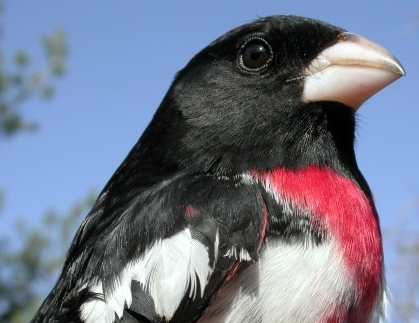
The Rose-breasted Grosbeaks returned early this week, and within a couple of days we had banded our first three males. This after-second-year male was unusually gentle, only once briefly nipping the bander; the second-year male banded later the same day applied a much firmer grip with its beak!
| THIS WEEK | WINTER TOTAL | YEAR TOTAL | SITE TOTAL | |
|---|---|---|---|---|
| # birds (and species) banded | 55 (18) | 318 (40) | 377 (44) | 1298 (60) |
| # birds (and species) repeat | 12 (7) | 60 (11) | 94 (11) | 272 (23) |
| # birds (and species) return | 2 (2) | 15 (5) | 25 (6) | 27 (7) |
| # species observed | 68 | 100 | 103 | 147 |
| # net hours | 109.4 | 869.4 | 927.4 | 1901.9 |
| # birds banded / net hour | 50.3 | 36.6 | 41.9 | 68.2 |
Bander-in-charge: Marcel Gahbauer
Assistants: Mélisa Brunet, Jean Demers, Barbara Frei, Marie-Anne Hudson, Barbara and Don MacDuff, Crissy Ranellucci, Clemence Soulard
Notes: Finally this week it felt like spring has really arrived! With temperatures up to 26 Celsius on Tuesday we expected the push of warm southern air to bring in a fresh load of migrants, and Wednesday morning we were not disappointed. All of a sudden there were Yellow Warblers everywhere, along with smaller numbers of Baltimore Orioles, and various other warblers and flycatchers. We recorded a single-day high of 56 species, despite being present for only 4 hours! A sudden reversal of weather brought sub-zero wind chills the next morning, which put an abrupt halt to the migration once again.
Rain again cost us a couple of days, and so that banding total for the week isn’t great, though the hourly rate is much higher than we’ve had all season. From the days that we were able to open, banding highlights this week were many. We added 10 species to the list of species banded this spring, of which 6 were altogether new for MBO: Yellow-bellied Sapsucker, Great Crested Flycatcher, Least Flycatcher, Yellow Warbler, Rose-breasted Grosbeak, and Baltimore Oriole. In total, we also added 16 species to the list of species observed this spring, bringing us to 100 with a good number yet to arrive.
Saturday we took a day of from regular operations to hold our all-day Birdathon. Despite a cloudy, cool, and largely rainy day, we were able to find 108 species at MBO and beyond, and in the process raised over $1500 for McGill Bird Observatory and Bird Studies Canada. Click here for details on our Birdathon experience.
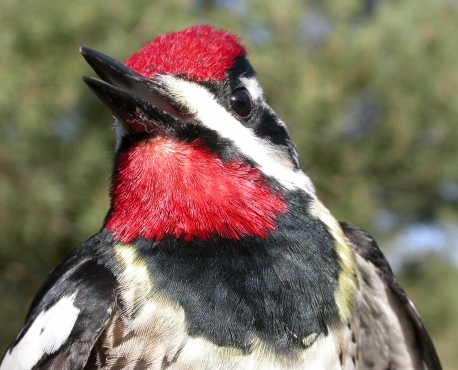
Another splash of red this week came courtesy of this male Yellow-bellied Sapsucker. Although the sapsuckers have been back in the area for a few weeks, they have
generally remained on the far slope, and this is the first one ever banded at MBO.
Week 8: May 16 – 22
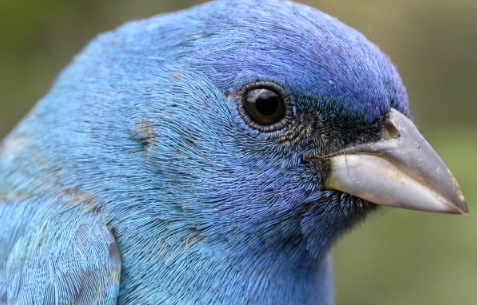
We were delighted to find this Indigo Bunting in a net on Monday morning, adding blue to the vivid palette of colours that morning which also featured many Rose-breasted Grosbeaks, Baltimore Orioles, and Yellow Warblers, among others. As a second-year male it still retained some brown juvenile feathers on the wings and back, but was a spectacular sight all the same.
| THIS WEEK | WINTER TOTAL | YEAR TOTAL | SITE TOTAL | |
|---|---|---|---|---|
| # birds (and species) banded | 163 (39) | 481 (56) | 540 (60) | 1461 (73) |
| # birds (and species) repeat | 55 (12) | 115 (15) | 149 (15) | 327 (26) |
| # birds (and species) return | 2 (1) | 17 (5) | 27 (6) | 29 (7) |
| # species observed | 87 | 122 | 125 | 149 |
| # net hours | 274.7 | 1144.1 | 1202.1 | 2176.6 |
| # birds banded / net hour | 59.3 | 42 | 45.2 | 67.1 |
Banders-in-charge: Marcel Gahbauer, Lance Laviolette
Assistants: Shawn Craik, Jean Demers, Barbara Frei, Helen Garland, Gay Gruner, Marie-Anne Hudson, Meghan Laviolette, Marylise Lefevre, Michael Mayer, Betsy McFarlane, Julia Mlynarek, Crissy Ranellucci, Clemence Soulard, Rodger Titman
Notes: A week of spectacular colour and diversity! Previously this spring we’ve banded at most 18 species per week; over the past seven days we’ve more than doubled that with 39 different species banded, and even had two individual days with over 20!
Monday was our best day, with 57 birds of 22 species banded, and 60 species observed, all season highs. New birds for the year included Indigo Bunting, Blackpoll Warbler, Magnolia Warbler, and Chestnut-sided Warbler – all caught in the nets before being otherwise observed!
Tuesday was much quieter, but we still had a decent number of birds on hand for Richard Dagenais of Global Television, who came out to film a series of short interviews for Global Morning. A Tree Swallow and a Brown Thrasher posed particularly cooperatively for the camera.
Wednesday the numbers built up again, with several further additions to the banding list: Tennessee Warbler, Northern Waterthrush, American Redstart, and Eastern Kingbird. For the second day in a row we had a Ruby-throated Hummingbird fly into net A1; we don’t band them, but are recording age and sex, to share with hummingbird banders in Ontario.
Though the weekend was largely wet, a good morning of banding was still squeezed in on Saturday before the rain became steady. Again several new species were banded – White-breasted Nuthatch (at last!), Blackburnian Warbler, Black-throated Blue Warbler, Wilson’s Warbler, and Red-eyed Vireo.
In total for the week, we added 22 species to the list of birds observed this spring, and 16 to the list of species banded, including 13 which we had never banded at MBO previously. While we don’t expect many additional species to arrive over the next week or two, we do anticipate that many individual migrants will yet be passing through.
Meanwhile, some species have already been nesting for a while. Both of our resident pairs of Canada Geese were promenading small goslings around in recent days, while a check of the nest boxes revealed that two pairs of Tree Swallows and one pair of House Sparrows are incubating eggs. Also known to already be nesting in the area are American Robin, Rose-breasted Grosbeak, Red-winged Blackbird, Eastern Phoebe, Mourning Dove, Brown Thrasher, and Common Grackle.
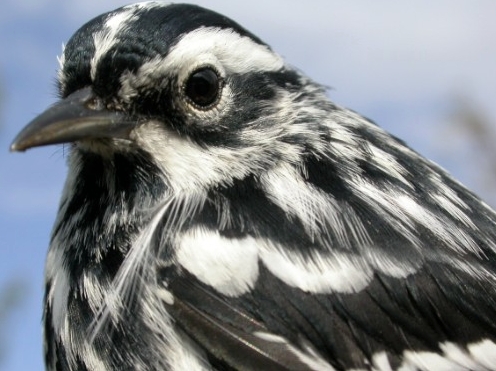
Not as colourful as some of the birds banded this week, but very striking in appearance nonetheless. This second-year male lack-and-white Warbler was
the first of its kind banded at MBO.
Week 9: May 23 – 29
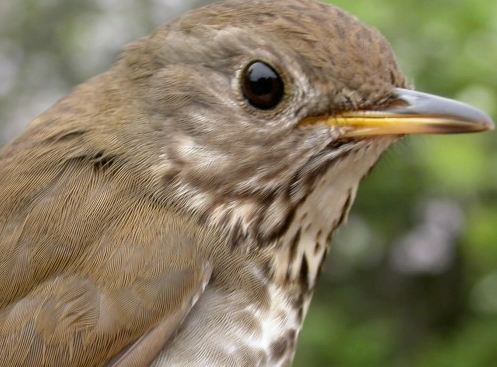
McGill Bird Observatory doesn’t band all that many thrushes, so it’s always a nice surprise to find one in the nets. They aren’t always easy to identify though – take a guess at what species this is before scrolling down to read about it in the weekly notes.
| THIS WEEK | WINTER TOTAL | YEAR TOTAL | SITE TOTAL | |
|---|---|---|---|---|
| # birds (and species) banded | 110 (30) | 591 (59) | 650 (63) | 1571 (76) |
| # birds (and species) repeat | 58 (12) | 173 (18) | 207 (18) | 385 (28) |
| # birds (and species) return | 2 (2) | 19 (5) | 29 (6) | 31 (7) |
| # species observed | 84 | 130 | 133 | 153 |
| # net hours | 281.6 | 1425.7 | 1483.7 | 2458.2 |
| # birds banded / net hour | 39.1 | 41.5 | 44 | 63.9 |
Bander-in-charge: Marcel Gahbauer
Assistants: Jean Demers, Barbara Frei, Gay Gruner, Barbara MacDuff, Betsy McFarlane, Chris Murphy, Crissy Ranellucci, Nicole Rose, Clemence Soulard, Arnaud Tarroux, Alain Theriault, Mona Wizenberg
Notes: A much quieter period than last week, due largely to the weather. A remarkably persistent weather system resulted in more than 7 straight days (and nights) of moderate to strong northeast winds, effectively putting a halt to most migration, and also making it hard to operate the nets effectively even for the birds which did make it through. For much of the week the wind was accompanied by rain, but despite that we did manage to squeeze in four mornings of banding, none of which were curtailed too greatly by the rain
The number of birds banded rose daily throughout the week, perhaps reflecting the growing number of birds waiting for decent weather to push north, and beginning to trickle through despite the weather. Again it was a fairly diverse week, with 30 species banded, including another three new for the season and the station as a whole.
Unquestionably, the bird of the week (year?) was a probable Bicknell’s Thrush, the first bird of Friday morning. Though the species breeds to the north of us in Mont Tremblant, it is rarely observed on migration, so we were quite stunned to see it. Many measurements were taken, all of them fitting within the known range for not only Bicknell’s Thrush, but also Grey-cheeked and Veery. Overall though the Bicknell’s is the only species for which not only the measurements, but also all the plumage characteristics match up consistently well. Nonetheless, we are checking out additional references, given the variability among known subspecies. For several more photos of this bird, click here.
Of course there were plenty of other interesting birds too, including a good number of warblers, our first Northern Rough-winged Swallow, and another half-dozen Baltimore Orioles. New birds for the site observed this week included Marsh Wren and Mourning Warbler, both part of the big wave of migrants that came in on Friday night in time for the Saturday morning census. Some relatively common but late migrants, such as Eastern Wood-Pewee and Swainson’s Thrush, have yet to arrive, so we expect that our upcoming final week of Spring Migration Monitoring 2005 will be another busy one.
Week 10: May 30 – June 5
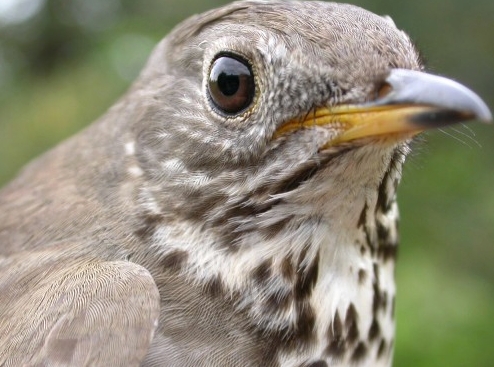
McGill Bird Observatory’s first Grey-cheeked Thrush, caught on Monday and providing a nice
contrast with the Bicknell’s Thrush banded the previous Friday
| THIS WEEK | WINTER TOTAL | YEAR TOTAL | SITE TOTAL | |
|---|---|---|---|---|
| # birds (and species) banded | 59 (26) | 650 (62) | 709 (66) | 1630 (78) |
| # birds (and species) repeat | 36 (13) | 209 (18) | 243 (18) | 421 (28) |
| # birds (and species) return | — | 19 (5) | 29 (6) | 31 (7) |
| # species observed | 70 | 134 | 137 | 155 |
| # net hours | 137.2 | 1562.9 | 1620.9 | 2595.4 |
| # birds banded / net hour | 43 | 41.6 | 43.9 | 62.8 |
Bander-in-charge: Marcel Gahbauer
Assistants: Daniel Brown, Barbara Frei, Gay Gruner, Barbara MacDuff, Betsy McFarlane, Chris Murphy
Notes: Our first full spring season came to an end this week, but not without some more highlights. Monday morning we had a good push of late migrants, including at last our first Grey-cheeked Thrush – a bird which, in combination with many articles read over the past week, convinced us that last Friday’s thrush was indeed a Bicknell’s. Also coming through the same day we had a Swainson’s Thrush and Yellow-bellied Flycatcher, bringing our season total of species banded to over 60.
Tuesday it suddenly felt like summer, and the birds reacted accordingly – most of the more northern migrants headed off overnight, with only a few lingering individuals still around for the morning. One of those was a Wilson’s Warbler with the most incredibly bulging fat deposits we’ve seen all spring – he clearly had a long way to go yet, and was prepared for the flight! We wrapped up for the season with an American Redstart (a local breeding male) and a Blackpoll Warbler (one of the latest migrants still trickling past). Meanwhile, an oddly hollow call in the distance turned out to be our first Yellow-billed Cuckoo.
The last three days of the season were decidely more summer-like than spring-like, with temperatures around 30 Celsius each afternoon and an abundance of mosquitoes throughout the site. With migration mostly over, the number of species in the area has stabilized around 50, with around 80% of them seen almost daily. We will keep track of the local population through the summer with census at least three days per week, and will resume migration monitoring in August.

The final bird banded of the 2005 Spring MIgration Monitoring Program, a
second-year male Blackpoll Warbler.
Below is a gallery of this season’s photographs – click on any thumbnail to open and browse
- A milestone at MBO – the Song Sparrow above was our 1000th bird banded since starting operations last May. An appropriate species with which to mark the occasion,as later the same day we banded our 100th Song Sparrow!
- The moult of the American Goldfinches continues! This second-year male caught this week is again much more yellow than those we’ve seen previously this year. However, patches of old beige feathers remain conspicuous on the crown and (less visible from this angle) the nape
- An exciting catch at the end of week 4 was this Rusty Blackbird, the first banded at MBO. As a rapidly declining boreal species, the Rusty Blackbird is among our top priorities for monitoring, and after seeing several flocks narrowly miss the nets last fall, we were very happy to catch and band this male.
- One of the most common breeding birds at MBO, Red-winged Blackbirds have nonetheless avoided the nets so far this spring. The first one caught was this second-year male, still showing much rusty edging on the wings and back, and with orange rather than fully red epaulets.
- Though common at MBO, we had not banded a Yellow-shafted Flicker until this third-year male landed in net A1 this Wednesday.
- The Rose-breasted Grosbeaks returned early this week, and within a couple of days we had banded our first three males. This after-second-year male was unusually gentle, only once briefly nipping the bander; the second-year male banded later the same day applied a much firmer grip with its beak!
- We were delighted to find this Indigo Bunting in a net on Monday morning, adding blue to the vivid palette of colours that morning which also featured many Rose-breasted Grosbeaks, Baltimore Orioles, and Yellow Warblers, among others. As a second-year male it still retained some brown juvenile feathers on the wings and back, but was a spectacular sight all the same.
- A rare view of an Eastern Kingbird’s red crown feathers.
- The final bird banded of the 2005 Spring MIgration Monitoring Program, a second-year male Blackpoll Warbler.
- A House Finch from our study wearing a colour band (left), and a closer view of the band (right).
- On Tuesday morning a flock of over 40 Cedar Waxwings was feeding on the buckthorn berries, and 7 individuals got caught in net C2. The group included all four age/sex classes, giving us a great opportunity for comparison. The individual in this photo is a second-year male, the sex evident from the extensive black on the chin.
- The moult of the American Goldfinches continues! This second-year male caught this week is again much more yellow than those we’ve seen previously this year. However, patches of old beige feathers remain conspicuous on the crown and (less visible from this angle) the nape.
- [Left] One of the most common breeding birds at MBO, Red-winged Blackbirds have nonetheless avoided the nets so far this spring. The first one caught was this second-year male, still showing much rusty edging on the wings and back, and with orange rather than fully red epaulets. [Right] A male Ruby-crowned Kinglet hanging out in one of our newest weighing tubes. These, inspired by similar ones in use at Prince Edward Point Bird Observatory in Ontario, allow us to put the bird in for weighing from one end, and then remove a cap from the other end to let them fly out, rather than backing out the tube. They have been a great success, though every once in a while we get a bird like this that seems quite content to sit inside for a while before taking flight.
- A female Red-winged Blackbird with red on the wing? Yes! While they often have little or no red in the coverts, some females do show a substantial amount of colour. It is thought that the amount of red may increase with age, but this has not yet been reliably established. This is by far the greatest amount of red we have seen on a female banded at MBO.
- This after-second-year Common Yellowthroat is among the very few warblers that have appeared at MBO to date this spring.
- Another splash of red this week came courtesy of this male Yellow-bellied Sapsucker. Although the sapsuckers have been back in the area for a few weeks, they have generally remained on the far slope, and this is the first one ever banded at MBO.
- Not as colourful as some of the birds banded this week, but very striking in appearance nonetheless. This second-year male lack-and-white Warbler was the first of its kind banded at MBO.
- McGill Bird Observatory doesn’t band all that many thrushes, so it’s always a nice surprise to find one in the nets. They aren’t always easy to identify though – take a guess at what species this is before scrolling down to read about it in the weekly notes.
- McGill Bird Observatory’s first Grey-cheeked Thrush, caught on Monday and providing a nice contrast with the Bicknell’s Thrush banded the previous Friday
